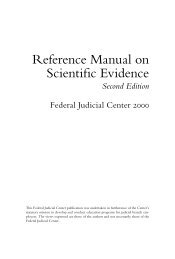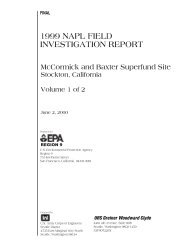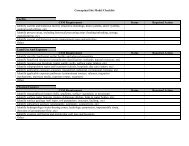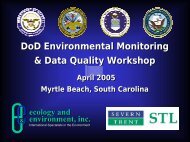Table 6-2. Estimated Cost for OU 12 Vadose <strong>Zone</strong> Investigation Using DPTTask Duration Quantity Unit Unit Cost Total Cost Assumptions(days)Project PlansDraft Work Plan 40 1 ls $20,000 $20,000 Assume standard cost and preparation time for project plans (WP, HASP, and SAP).USAF Review 30 --- --- --- --- Assume standard 30-day review cycle.Final Work Plan 21 1 ls $5,000 $5,000 Assume standard time and cost to respond to comments and modify project plans.Subtotal $25,000Phase I InvestigationCoordination and Planning 5 40 hr $65 $2,600 Includes subcontractor coordinate, site preparation, utilities clearance, cleanup, and IDW disposal.Sample Collection 9- mobilization/demobilization --- 1.5 hr $110 $165 Assume local mobilization/demobilization cost.- DPT rig with operator --- 108 hr $140 $15,120 Drill 17 locations to 60 ft bgs with sample collection every 2 ft starting at 20 ft bgs for a total of 20- drillers assistant --- 108 hr $45 $4,860 samples per location. Assume 2 locations per day = 9 days x 12 hr/day = 108 hrs.- field geologist --- 108 hr $65 $7,020 Assume 9 days x 12 hr/day = 108 hrs for field geologist to log cores and collect samples.- bentonite grout --- 34 bag $25 $850 Assume 2 bags of bentonite grout per location; 17 total locations.- sample shipment --- 18 ea $75 $1,350 Assume overnight shipping includes 2 shipments/day x 9 days = 18 shipments.Off-Site Laboratory Analysis 15 374 ea $135 $50,490 Assume 10% QC samples; 20 samples/loc x 17 loc x 1.1 = 374 samples.Subtotal $82,455Data Evaluation and <strong>Report</strong>ingUpdate CSM 14 80 hr $90 $7,200 Assume an average rate of $65/hr for geologist and $115/hr for hydrogeologist/engineer.Draft Tech Memo/Sampling Plan 21 60 hr $90 $5,400 Assume an average rate of $65/hr for geologist and $115/hr for hydrogeologist/engineer.USAF Review 30 --- --- --- --- Assume standard 30-day review cycle.Final Tech Memo/Sampling Plan 14 24 hr $90 $2,160 Assume an average rate of $65/hr for geologist and $115/hr for hydrogeologist/engineer.Subtotal $14,760Phase II Investigation (Data Gap Collection)Coordination and Planning 5 24 hr $65 $1,560 Includes subcontractor coordinate, site preparation, utilities clearance, cleanup, and IDW disposal.Sample Collection 3- mobilization/demobilization --- 1.5 hr $110 $165 Assume local mobilization/demobilization cost.- DPT rig with operator --- 36 hr $140 $5,040 Drill 6 locations to 60 ft bgs with sample collection every 2 ft starting at 20 ft bgs for a total of 20- drillers assistant --- 36 hr $45 $1,620 samples per location. Assume 2 locations per day =3 days x 12 hr/day = 36 hrs.- field geologist --- 36 hr $65 $2,340 Assume 3 days x 12 hr/day = 36 hrs for field geologist to log cores and collect samples.- bentonite grout --- 12 bag $25 $300 Assume 2 bags of bentonite grout per location; 6 total locations.- sample shipment --- 6 ea $75 $450 Assume 2 shipments/day x 3 days = 6 shipments.Off-Site Laboratory Analysis 15 132 ea $135 $17,820 10% QC samples; 20 samples/loc x 6 loc x 1.1 = 132 samples.Subtotal $29,295Remedial Investion (RI) <strong>Report</strong>Update CSM 10 48 hr $90 $4,320 Assume an average rate of $65/hr for geologist and $115/hr for hydrogeologist/engineer.Draft RI <strong>Report</strong> 30 120 hr $90 $10,800 Assume an average rate of $65/hr for geologist and $115/hr for hydrogeologist/engineer.USAF Review 30 --- --- --- --- Assume standard 30-day review cycle.Final RI <strong>Report</strong> 21 40 hr $90 $3,600 Assume an average rate of $65/hr for geologist and $115/hr for hydrogeologist/engineer.ERPIMS Data Package --- 48 hr $70 $3,360 Laboratory includes ERPIMS-formatted electronic data package.Subtotal $22,080IDW Disposal (Soil)Drum and Hazardous Waste Tranportation --- 1 ls $500 $500 Assume three 55-gallon drums of TCE-contaminated soil generated during sampling.Hazardous Waste Disposal (Incineration) --- 2000 lb $0.29 $580 Assume 87 lb TCE-contaminated soil per location using 2-inch diameter DPT rod, 40 ft totalRCRA State Tipping Fee --- 1 ton $28 $28 depth per location, and bulk soil density of 100 lb/cubic foot; 23 total locationsSubtotal $1,108Travel 18 hr $65 $1,170 Assume 1.5 hr/day x 18 days (9 days for phase I and 3 days for phase II) local travel for geologist.Subtotal 313 --- --- --- $175,868Project Management --- --- --- --- $17,587 Assume 10% of project subtotal cost for project management.Total $193,455March 2003 6-4OU 12 <strong>Demonstration</strong> <strong>Report</strong>Final
For the conventional investigation, it is assumed that soil samples are analyzed by an off-site analyticallaboratory for the full suite of VOC analytes according to USEPA SW846 Method 8260. This is incontrast to the adaptive investigations that employ an on-site laboratory using DSITMS to analyze the soilsamples for an abbreviated analyte list (TCE, PCE, DCE, and vinyl chloride) according to USEPASW846 Method 8265. The costs associated with project planning, data evaluation and reporting, and thepreparation of a RI report are assumed identical for both the HAS and DPT investigations.6.1.1 Hollow Stem Auger (HSA)The total estimated cost of a hypothetical HSA investigation is $215,250 (see Table 6-1) representing thehighest cost of the four hypothetical investigations considered as part of this analysis. By comparison, theestimated costs associated with the other investigative methods are $193,460 ($21,790,or 10% less) forDPT, $149,620 ($65,630, or 30% less) for WS/DSITMS; and $125,100 ($90,150, or 42% less) forSVE/DSITMS.Two primary reasons account for the elevated cost associated with the HSA investigation: (1) directdrilling costs and (3) the investigative-derived waste (IDW) disposal charges. Direct drilling costsinclude the expense of mobilization and demobilization, actual drilling costs, the cost to decontaminateequipment during and after drilling operations, and borehole abandonment. The total direct drilling costsfor both phases of the HSA investigation are $37,160. This is compared to $28,120 in direct drilling forthe DPT investigation, a difference of $9,040 or 24% less (decontamination is not shown as a separateline item but is included in the hourly equipment and field crew rate for the DPT investigation). The costof IDW disposal for the HSA investigation is $11,880 and is estimated assuming an 8.25-inch auger and40 feet of contaminated soil (upper 20 feet of vadose zone is assumed uncontaminated) in each of 23borings. If a 6-inch auger is used, the IDW disposal cost is reduced by approximately $5,500. In eithercase, IDW disposal cost is considerably more than the estimate $1,100 incurred during the DPTinvestigation. The difference in the IDW disposal cost is due to the larger diameter boring andsubsequent increase in the volume of contaminated waste generated with the HSA investigation.Although the HSA investigation is estimated to be the most expensive, it does have some advantages overother investigative techniques. One advantage associated with HSA is the ability to construct a well in aboring following soil sampling. The decision to construct a well may be based on field observations, ormay part included in the original investigation plan. With any of the other investigative techniquesconsidered as part of this cost analysis, the decision to construct a well would incur additional drillingcosts. In addition, HSA is more robust than DPT in terms of penetration into the vadose zone. AlthoughHSA may encounter difficulty penetrating gravels and cobbles, it is likely to be more successful in thesesoils than DPT. Finally, HSA allows for the continuous logging of soil cores during a soil samplinginvestigation whereas continuous logging cannot adequately be performed using WS/DSITMS.March 2003 6-5 OU 12 <strong>Demonstration</strong> <strong>Report</strong>Final
- Page 1 and 2:
FinalSource Zone Delineation Demons
- Page 3 and 4:
EXECUTIVE SUMMARYThis report docume
- Page 5:
The SVE demonstration conducted in
- Page 8 and 9:
TABLE OF CONTENTSEXECUTIVE SUMMARY
- Page 10 and 11:
LIST OF FIGURESFigure ES-1 Iso-Conc
- Page 12 and 13:
Figure 5-38 Horizontal slices at fi
- Page 14 and 15:
LIST OF ACRONYMS AND ABBREVIATIONSA
- Page 16 and 17:
Hill Air Force BaseUtahRIVERDALEWeb
- Page 18 and 19:
Co-Team LeaderCo-Team LeaderURS Pro
- Page 20 and 21:
1.4 Report OrganizationThe remainin
- Page 22 and 23:
Davis-Weber CanalDetail AreaHillAir
- Page 24 and 25:
ANorthSouthU5-18864,580CROSS SECTIO
- Page 26 and 27:
Approx. LocationOf BarrelsInitial S
- Page 28 and 29:
Figure 3-2. Wireline locking and re
- Page 30 and 31:
3.3 DSITMS Soil AnalyticsDirect sam
- Page 32 and 33:
4.0 SOIL VAPOR EXTRACTION DEMONSTRA
- Page 34 and 35:
The equilibrium four-phase distribu
- Page 36 and 37:
3520 ft. from well, 3.5 cfmTCE in E
- Page 38 and 39:
The SVE system included piping from
- Page 40 and 41:
SVE Process System and On-Site DSIT
- Page 42 and 43:
Table 4-3. Summary of OU 12 SVE Ste
- Page 44 and 45:
3,000U12-VP1 Calibration Curve2,500
- Page 46 and 47:
5.0 RESULTS OF SOIL SAMPLING AND SV
- Page 48 and 49:
0U12-1802100U12-1803100U12-18051020
- Page 50 and 51:
0102030405060700U12-1804U12-1807102
- Page 52 and 53:
Figure 5-4. Soil samples collected
- Page 54 and 55:
298400298360Northing (ft)2983202982
- Page 56 and 57:
298400298360Northing (ft)2983202982
- Page 58 and 59:
The final TCE soil contamination mo
- Page 60 and 61:
298400298360Northing (ft)2983202982
- Page 62 and 63:
Figure 5-12. Isometric view, lookin
- Page 64 and 65:
An isometric view of the upscaled a
- Page 66 and 67:
March 2003 5-21 OU 12 Demonstration
- Page 68 and 69:
4620WE460045804560454045204500Verti
- Page 70 and 71:
4620WE460045804560Elevation (ft)454
- Page 72 and 73:
Volumetric calculations yield an es
- Page 74 and 75:
The position of the water table in
- Page 76 and 77:
5.2 OU 12 SVE EvaluationThe OU 12 S
- Page 78 and 79:
Vapor Probe #1Vapor Probe #2Vapor P
- Page 80 and 81:
Thus, the in situ air permeability
- Page 82 and 83:
0.0000-0.0010U12-VP1 ResponsePressu
- Page 84 and 85: 0.000020.00000U12-VP1 ResponsePress
- Page 86 and 87: Table 5-5. Estimated In Situ Air Pe
- Page 88 and 89: 10.0U12-VP1 Pneumatic Response8.0Ai
- Page 90 and 91: 1,400841,20072TCE Concentration (pp
- Page 92 and 93: 800.98700.84TCE Concentration (ppmv
- Page 94 and 95: 200.018180.016TCE Concentration (pp
- Page 96 and 97: 1400.491200.42TCE Concentration (pp
- Page 98 and 99: 4600OU12-VP1OU12-VP2 OU12-VP3 OU12-
- Page 100 and 101: the screened interval in U12-VP1 an
- Page 102 and 103: permeability layer. Final adjustmen
- Page 104 and 105: Table 5-7. Comparison of Measured a
- Page 106 and 107: Table 5-8. continuedFile Name Extra
- Page 108 and 109: U12-1802U12-VP3U12-1812U12-1803U12-
- Page 110 and 111: U12-1802U12-VP3U12-1812U12-1803U12-
- Page 112 and 113: U12-1802U12-VP3U12-1812U12-1803U12-
- Page 114 and 115: Figure 5-42 shows a comparison betw
- Page 116 and 117: U12-VP1 50 mg/kg source 10 ft thick
- Page 118 and 119: 5 10 15 20 25 30 35 40 455 10 15 20
- Page 120 and 121: 25 - 30 feet bgs30 - 35 feet bgs35
- Page 122 and 123: U12-VP1 200 mg/kg source 10 ft thic
- Page 124 and 125: A comparison between the predicted
- Page 126 and 127: 5 10 15 20 25 30 35 40 455 10 15 20
- Page 128 and 129: U12-VP1 EVS Maximum Soil Concentrat
- Page 130 and 131: 9,200Predicted TCE Concentration (p
- Page 132 and 133: 6.1 Conventional Sampling and Analy
- Page 136 and 137: 6.1.2 Direct Push Technology (DPT)T
- Page 138 and 139: Table 6-4. Estimated Cost for OU 12
- Page 140 and 141: that the Wireline CPT sampler canno
- Page 142 and 143: Table 6-5. Summary of Estimated Cos
- Page 144 and 145: The Wireline CPT tool is not effect
- Page 146 and 147: Figure 7-1. Iso-concentration surfa
- Page 148 and 149: 24U12-VP5 Combined Testing201612846
- Page 150 and 151: 8.0 REFERENCESBear, J. 1979. Hydrau
- Page 152 and 153: TABLE A-1FIELD ANALYICAL RESULTS FO
- Page 154 and 155: TABLE A-1FIELD ANALYICAL RESULTS FO
- Page 156 and 157: TABLE A-1FIELD ANALYICAL RESULTS FO
- Page 158 and 159: TABLE A-1FIELD ANALYICAL RESULTS FO
- Page 160 and 161: TABLE A-1FIELD ANALYICAL RESULTS FO
- Page 162 and 163: TABLE A-1FIELD ANALYICAL RESULTS FO
- Page 164 and 165: TABLE A-1FIELD ANALYICAL RESULTS FO
- Page 166 and 167: TABLE A-1FIELD ANALYICAL RESULTS FO
- Page 168 and 169: TABLE A-1FIELD ANALYICAL RESULTS FO
- Page 170 and 171: APPENDIX BSimulated TCE Vapor-Phase
- Page 172 and 173: TCE Concentration (ppmv2,4702,4602,
- Page 174 and 175: U12-PV1Source Area #2TCE Concentrat
- Page 176 and 177: U12-PV1Source Area #2250VP1 i=24, j
- Page 178 and 179: U12-PV1Source Area #3TCE Concentrat
- Page 180 and 181: U12-PV1Source Area #4TCE Concentrat
- Page 182 and 183: TCE Concentration (ppmv4,9004,8004,
- Page 184 and 185:
TCE Concentration (ppmvTCE Concentr
- Page 186 and 187:
U12-PV1Source Area #6TCE Concentrat
- Page 188 and 189:
U12-PV1Source Area #7TCE Concentrat
- Page 190 and 191:
TCE Concentration (ppmv1,7301,7201,
- Page 192 and 193:
TCE Concentration (ppmv6,0005,0004,
- Page 194 and 195:
U12-PV1Source Area #8TCE Concentrat
- Page 196 and 197:
U12-PV1Source Area #9500450VP1 i=24
- Page 198 and 199:
TCE Concentration (ppmTCE Concentra
- Page 200 and 201:
700600U12-PV1Source Area #9VP1 i=24
- Page 202 and 203:
U12-PV2Source Area #1TCE Concentrat
- Page 204 and 205:
U12-PV2Source Area #3TCE Concentrat
- Page 206 and 207:
U12-PV2Source Area #7TCE Concentrat
- Page 208 and 209:
U12-PV2Source Area #7TCE Concentrat
- Page 210 and 211:
TCE Concentration (ppmv1,4001,2001,
- Page 212 and 213:
U12-PV2Source Area #7TCE Concentrat
- Page 214 and 215:
U12-PV2Source Area #7TCE Concentrat
- Page 216 and 217:
U12-PV2Source Area #8TCE Concentrat
- Page 218 and 219:
U12-PV2Source Area #8TCE Concentrat
- Page 220 and 221:
U12-PV2Source Area #10250VP2 i=23,
- Page 222 and 223:
U12-PV3Source Area #9TCE Concentrat
- Page 224 and 225:
U12-PV4Source Area #7TCE Concentrat
- Page 226 and 227:
U12-PV4Source Area #9TCE Concentrat
- Page 228 and 229:
TCE Concentration (ppm1.00.90.80.70
- Page 230 and 231:
U12-PV6Source Area #7TCE Concentrat
- Page 232 and 233:
U12-PV6Source Area #8TCE Concentrat
- Page 234 and 235:
U12-PV6Source Area #101816VP6 i=33,
- Page 236:
TCE Concentration (ppm6050403020100










